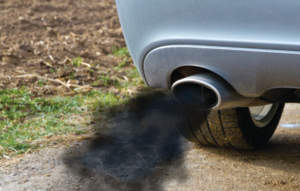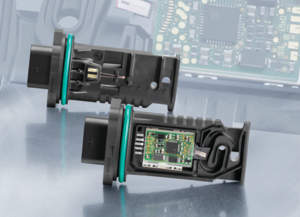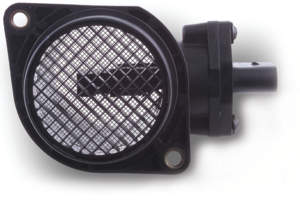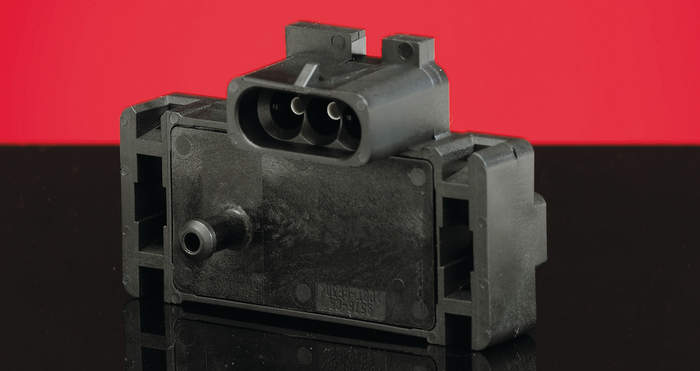Pattern failures are those failures that happen over and over again — and the same applies to how customers describe these failures. Customers might unknowingly give you the answer to their problem without needing to open the hood. In this article, we will look both at the failures of these sensors and the actual customer explanations that directly related to a failed MAP or MAF sensor.
 MAP Sensor Operation
MAP Sensor Operation
A Manifold Absolute Pressure Sensor (MAP) measures the pressure inside the intake manifold. This information, along with other engine sensors, is used by the PCM to adjust for the correct fuel/air mixture. MAP sensor readings can be affected by numerous outside conditions such as engine condition, vacuum or electrical issues.
What is Absolute Pressure?
Absolute pressure is the maximum pressure (or lack of) measured from zero, which is 100% vacuum. A pressure or vacuum gauge indicates zero pressure when it’s not connected, however, there actually is pressure. It’s the atmospheric pressure that surrounds the earth, referred to as the barometric pressure. The MAP sensor signal is also used by the PCM to calculate the fuel requirements and is based on what is called the speed-density method of calculating engine load. This engine load calculation is what makes the accuracy of the MAP sensor signal so critical.
Customer Comments For MAP Sensor Pattern Failures
Customer: “I was driving down the freeway, and when I pulled off of the highway, the guy behind me rolled his window down and told me my car was blowing black smoke out the tailpipe. Now it’s hard to start when it’s warmed up.”
Technician: The MAP sensor uses engine vacuum to work properly and without that vacuum the sensor is reading barometric pressure. Most likely it’s a broken vacuum hose or the hose has come off the MAP sensor.
Customer: “My car seems to buck and surge, especially when it’s idling, but it has surged up and down when I’m driving, too.”
Technician: Surging problems and idling problems are quite common in cars with faulty MAP sensors. These surges can happen immediately after the engine is started as well as when your car is idling at a red light.
Customer: “The car is idling rough, and sometimes stalls, but other times it runs perfectly.”
Technician: Rough idle is another pattern failure of a MAP sensor. Other symptons could be a loss of power or sputtering engine conditions. Even if you have no obvious surging or sputtering, if the engine has a faulty MAP sensor, the idling will likely be rough. This condition can happen immediately after starting the car as well as while driving.
 MAF Sensor Operation
MAF Sensor Operation
The Mass Air Flow sensor (MAF) does just as its name implies; it senses the mass of air being delivered to the engine. Air density varies with the ambient temperature, altitude and other external conditions. This information is necessary for the PCM to balance out the correct fuel ratio.
There are two common types of MAF sensors in use on automotive engines: the vane meter (on older configurations such as early Bosch setups) and the hot wire. Both sensor designs output a 0.0–5.0 volt or a pulse-width modulation (PWM) signal that is proportional to the air mass flow rate. The hot wire type is the most common on today’s engine systems.
The hot wire MAF uses a heated wire suspended in the air stream, sort of like a toaster wire, with either a constant voltage over the wire or a constant current through the wire. The wire’s electrical resistance increases as the wire’s temperature increase, which varies the electrical signal. When air flows past the wire, the wire cools, decreasing its resistance, which in turn allows more current to flow through the circuit or causes a smaller voltage drop over the wire. As more current flows, the wire’s temperature increases until the resistance reaches equilibrium again.
If the air density increases due to a pressure increase or a temperature drop, but the air volume remains constant, the denser air will remove more heat from the wire, indicating a higher mass airflow rate to the PCM. Unlike the vane meter’s paddle sensing element, the hot wire responds directly to air density.
An engine with a bad MAF sensor may be hard to start or may stall after starting. It may hesitate under load, surge and idle rough, or run excessively rich or lean. The engine may also hiccup when the throttle suddenly changes position.
 Customer Comments For MAF Sensor Pattern Failures
Customer Comments For MAF Sensor Pattern Failures
Customer: “The car is hard to start and it seems jumpy.”
Technician: Hard starting and hesitation under a load or even a surge are very common problems with a faulty MAF sensor.
Customer: “The car hiccups when I take off.”
Technician: This can be a result of the hot wire not evaluating the actual air density and is either leaning out the mixture or making it too rich.
Customer: “When I can get it started it runs really rough. I looked under the hood and didn’t see anything wrong, but if I slam the hood down hard and then start it, it does seem to run a bit better for a while, so I think it’s a loose wire.”
Technician: What this might be indicating is the old tried and true method of tapping on the MAF sensor to see if the engine rpm or fuel trim changes. Slamming the hood down may have actually jarred the sensor enough to get it to respond one more time.
Knowing these typical pattern failures from both the mechanic side and the customer side may help solve an issue or at least eliminate any other possibilities.














